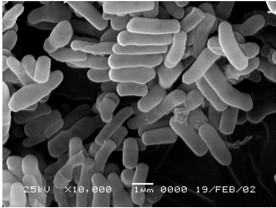Rhodococcus opacus B4 (=NBRC 108011)
Rhodococcus opacus B4 (=NBRC 108011) was isolated as an organic solvent-tolerant bacterium from gasoline-contaminated soil[1]. Members of the genus Rhodococcus are common in many environmental niches from soil to sea water and show remarkable metabolic versatility, including their ability to degrade a wide variety of organic compounds. They are high G+C Gram-positive bacteria classified into the order Actinomycetales, suborder Corynebacterineae, and family Nocardiaceae. R. opacus B4 utilize many aromatic and aliphatic hydrocarbons including benzene, toluene, xylene, ethylbenzene, propylbenzene, n-octane and n-decane as sole sources of carbon and energy. R. opacus B4 is able to retain their metabolic activity in organic solvents and therefore to mediate biosynthesis as a whole-cell catalyst [2].
Genome analysis of R. opacus B4 (=NBRC 108011) genome revealed six replicons composed of one linear chromosome (7,913,450 bp, 67.9% G+C, 7,252 ORF), two linear plasmids pROB01 (558,192 bp, 65.8% G+C, 593 ORF), pROB02 (244,997 bp, 64.2% G+C, 248 ORF), and three circular plasmids pKNR (111,160 bp, 65.0% G+C, 102 ORF), pKNR01 (4,367 bp, 64.5% G+C, 6 ORF) and pKNR02 (2,773 bp, 63.8% G+C, 2 ORF). R. opacus B4 genome showed overall conservation of synteny with sequenced Rhodococcus jostii RHA1 genome [3] which also possesses a linear chromosome. R. opacus B4 chromosome is more similar in its gene arrangement to the circular chromosome Nocardia farcinica than those of Mycobacterium tuberculosis and Corynebacterium glutamicum or the linear chromosome of Streptomyces coelicolor, being consistent with their taxonomic relationships. On the other hand, telomeric sequences of the three linear replicons were conserved with other actinomycete invertorons. The genome encodes extremely abundant catabolic pathways for aromatic compounds including benzene, benzoate, phenol, 4-nitrophenol, 4-hydroxybenzoate, p-cumate, catechol, protocatechuate, and phenylacetate. The genome further encodes genes involved in the degradation of various organic compounds including naphthalene, indene, nicotine, thiocarbamate herbicide (EPTC), and thiocyanate. Genome analysis of R. opacus B4 thus provides important insights into biochemical and genetic bases of the metabolic versatility of Rhodococcus.
This work was conducted as a part of the project "Development of a Technological Infrastructure for Industrial Bioprocesses" of the New Energy and Industrial Technology Development Organization (NEDO), Japan.

Courtesy of
Dr. Kato (Hiroshima univ.)
References:
- [1] Isolation and characterization of benzene-tolerant Rhodococcus opacus strains.
- Na, K. S., A. Kuroda, N. Takiguchi, T. Ikeda, H. Ohtake, and J. Kato. (2005)
J Biosci Bioeng 99:378-82. [PMID:16233805] - [2] Utilization of hydrophobic bacterium Rhodococcus opacus B-4 as whole cell catalyst in anhydrous organic solvents.
- Yamashita, S., M. Satoi, Y. Iwase, K. Honda, Y. Sameshima, T. Omasa, J. Kato, and H. Ohtake. (2007)
Appl Microbiol Biotechnol 74:761-767. [PMID:17123076] - [3] The complete genome of Rhodococcus sp. RHA1 provides insights into a catabolic powerhouse.
- McLeod, M. P., R. L. Warren, W. W. Hsiao, N. Araki, M. Myhre, C. Fernandes, D. Miyazawa, W. Wong, A. L. Lillquist, D. Wang, M. Dosanjh, H. Hara, A. Petrescu, R. D. Morin, G. Yang, J. M. Stott, J. E. Schein, H. Shin, D. Smailus, A. S. Siddiqui, M. A. Marra, S. J. Jones, R. Holt, F. S. Brinkman, K. Miyauchi, M. Fukuda, J. E. Davies, W. W. Mohn, and L. D. Eltis. (2006)
Proc Natl Acad Sci U S A 103:15582-7.
| chromosome | pROB01 | pROB02 | pKNR | pKNR01 | pKNR02 | TOTAL | |
|---|---|---|---|---|---|---|---|
| Genomic size (bps) | 7,913,450 | 558,192 | 244,997 | 111,160 | 4,367 | 2,773 | 8,834,939 |
| The number of ORFs | 7,252 | 593 | 248 | 102 | 6 | 2 | 8,203 |
| GC content (%) | 68.0 | 65.8 | 64.2 | 65.0 | 64.5 | 63.8 | |
| Genome Database | DOGAN | ||||||
- *:
- NBRC is the acronym for "the NITE Biological Resource Center".
The URL of NBRC is http://www.nbrc.nite.go.jp/e/index.html.
- Distribution of Our Microbial Genomic DNAs
- At the Biological Resource Center of the National Institute of Technology and Evaluation (NITE Biological Resource Center, an Incorporated Administrative Agency), we have been distributing the microbial genomic DNA.
Contact us
- Biotechnology Evaluation and Development Division, Biological Resource Center, National Institute of Technology and Evaluation
-
Address:2-49-10 Nishihara, Shibuya-ku, Tokyo 1510066, Japan MAP
Contact Form


